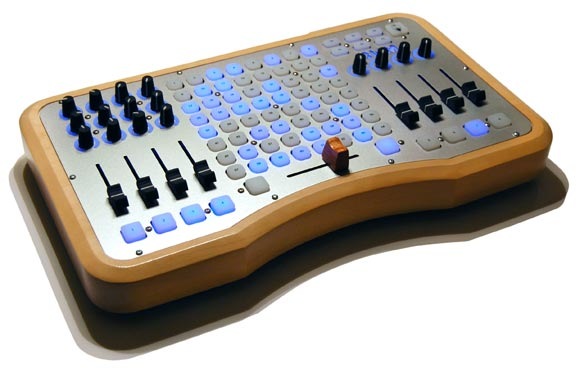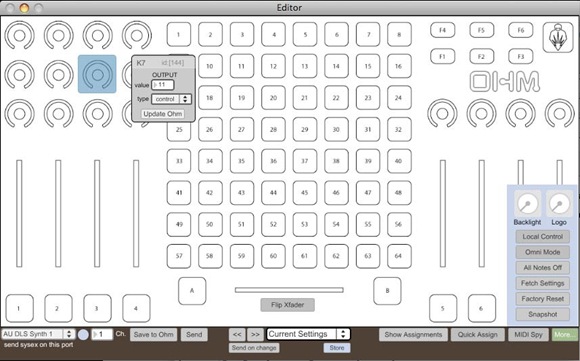So, you’ve been looking at that Akai APC40. And it’s appealing. It’s got lots of lights and a huge array of buttons for triggering samples or video or what have you, and plenty of knobs and faders.
Now the APC40 has some serious “indie” competition, though, in the form of Livid’s Ohm64. Let’s compare:
APC40:
- Proprietary connection to Ableton Live
- A proprietary handshake that ensures only a real APC is being used with Live
- Fixed MIDI assignments – no MIDI assignment editor
- MIDI only
- No MIDI out jacks, so you can’t use it with outboard gear
- No bus power
- 40 buttons
- Made in some factory somewhere we’ve never seen
Livid Ohm64:
- Open source editor, partially open source firmware, open source patches to connect to whatever you want
- Custom MIDI assignments, for use with whatever you want
- MIDI for now, but the chipset supports open source solutions for OpenSoundControl (OSC) in the near future – and even DMX (for lighting) is a possibility
- USB and standard MIDI jacks so you can sequence outboard gear
- Bus power
- 64 trigger buttons in a more logical 8×8 array
- “Made in the USA by humans” – with a beautifully-crafted body
- Free Cell DNA video software included
Both the APC and Ohm are class-compliant, so at least neither needs drivers to work over USB for MIDI on Mac, Windows, and Linux.
Sure, the APC is plug-and-play with Live. But just as lots of non-programmers use open source browsers like Firefox, the whole point is that the Ohm could wind up being more plug and play with more tools thanks to its more open approach.
Most important is the programmability of the Ohm64. You can make your own custom light interactions – or, if you’re not into that sort of programming, count on what may be a growing community of open source musicians and visualists doing it for you.
In fact, Livid is so committed to customization that in addition to the natural, blue, and red finishes, you can order it unfinished and stain or paint it whatever color you like.
The Ohm64 is also priced at just US$599, meaning it doesn’t cost much more than the APC40. And with future OSC support, hardware MIDI support, bus power so you don’t have to carry a dongle, fully programmable visual feedback and assignments, and open source editing software, the APC has some real explaining to do about what its long-term payoff may be.
The editor is currently built in Max/MSP with some interesting possibilities coming up in Max for Live, but I’m also interested in working on some editing and performance tools in fully open source environments. Stay tuned.
Now, mind, this isn’t a review – I’ll get my hands on the Ohm64 next week here in New York, and I’ve only had a brief encounter with the APC. But if I were a betting man, I have to say, the contest here isn’t looking like it’s in the APC’s favor.
Available now.
http://www.lividindustry.com/culture/ blog with more videos
Updated: I should note, one issue is definitely that, in order to maintain bus power, there are some compromises. You don’t get quite as much interaction from the lights as you do on the Akai APC – I do like the APC’s lovely LED rings around its encoders. You can interactively dim the lights on the knobs on the Ohm, though, which would work nearly as well. More once I get my hands on the Ohm, and theoretically, I should have an APC for testing at some point, too, assuming I didn’t just make Akai angry. (Uh…. competition is good. Blogs are all about opinions. Don’t hurt me.)
By the way, if you aren’t convinced and think you can do better, Livid is also distributing the brains of this device – the MIDIDIY – so you can build your own creations. Other such solutions exist, but the MIDIDIY is distinguished in its ability to support a lot more contacts for doing this sort of more complex device.
http://www.lividinstruments.com/hardware_mididiy.php

